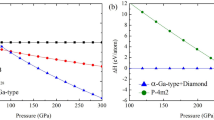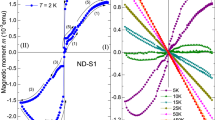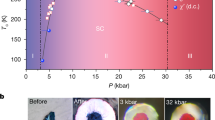Abstract
Diamond is an electrical insulator well known for its exceptional hardness. It also conducts heat even more effectively than copper, and can withstand very high electric fields1. With these physical properties, diamond is attractive for electronic applications2, particularly when charge carriers are introduced (by chemical doping) into the system. Boron has one less electron than carbon and, because of its small atomic radius, boron is relatively easily incorporated into diamond3; as boron acts as a charge acceptor, the resulting diamond is effectively hole-doped. Here we report the discovery of superconductivity in boron-doped diamond synthesized at high pressure (nearly 100,000 atmospheres) and temperature (2,500–2,800 K). Electrical resistivity, magnetic susceptibility, specific heat and field-dependent resistance measurements show that boron-doped diamond is a bulk, type-II superconductor below the superconducting transition temperature Tc ≈ 4 K; superconductivity survives in a magnetic field up to Hc2(0) ≥ 3.5 T. The discovery of superconductivity in diamond-structured carbon suggests that Si and Ge, which also form in the diamond structure, may similarly exhibit superconductivity under the appropriate conditions.
This is a preview of subscription content, access via your institution
Access options
Subscribe to this journal
Receive 51 print issues and online access
$199.00 per year
only $3.90 per issue
Buy this article
- Purchase on Springer Link
- Instant access to full article PDF
Prices may be subject to local taxes which are calculated during checkout




Similar content being viewed by others
References
Field, J. E. The Properties of Natural and Synthetic Diamond (Academic, New York, 1992)
May, P. W. Diamond thin films: a 21st-century material. Phil. Trans. R. Soc. Lond. A 358, 473–495 (2000)
Kalish, R. The search for donors in diamond. Diamond Relat. Mater. 10, 1749–1755 (2001)
Geis, M. W., Twitchell, J. C., Macauley, J. & Okano, K. Electron field emission from diamond and other carbon materials after H2, O2 and Cs treatment. Appl. Phys. Lett. 67, 1328–1330 (1995)
Teukam, Z. et al. Shallow donors with high n-type electrical conductivity in homoepitaxial deuterated boron-doped diamond layers. Nature Mater. 2, 482–486 (2003)
Garrido, J. A. et al. Fabrication of in-plane gate transistors on hydrogenated diamond surfaces. Appl. Phys. Lett. 82, 988–990 (2003)
Williams, A. W. S., Lightowlers, E. C. & Collins, A. T. Impurity conduction in synthetic semiconducting diamond. J. Phys. C 3, 1727–1735 (1970)
Vishnevskii, A. S., Gontar', A. G., Torishnii, V. I. & Shul'zhenko, A. A. Electrical conductivity of heavily doped p-type diamond. Sov. Phys. Semicond. 15, 659–661 (1981)
Werner, M. et al. Charge transport in heavily B-doped, polycrystalline diamond films. Appl. Phys. Lett. 64, 595–597 (1994)
Borst, T. H. & Weis, O. Boron-doped homoepitaxial diamond layers: fabrication, characterization and electronic applications. Phys. Status Solidi A 154, 423–444 (1996)
Zhang, R. J., Lee, S. T. & Lam, Y. W. Characterization of heavily boron-doped diamond films. Diamond Relat. Mater. 5, 1288–1294 (1996)
Eremets, M. I., Struzhkin, V. V., Mao, H.-K. & Hemley, R. J. Superconductivity in boron. Science 293, 272–274 (2001)
Werthamer, N. R., Helfand, E. & Hohenberg, P. C. Temperature and purity dependence of the superconducting critical field Hc2. III. Electron spin and spin-orbit effects. Phys. Rev. 147, 295–302 (1966)
McMillan, W. L. Transition temperature of strongly coupled superconductors. Phys. Rev. 167, 331–344 (1968)
Gurevich, V. L., Larkin, A. I. & Firsov, Yu. A. On the possibility of superconductivity in semiconductors. Sov. Phys. Solid State 4, 131–135 (1962)
Cohen, M. L. Superconductivity in many-valley semiconductors and in semimetals. Phys. Rev. 134, A511–A521 (1964)
Cohen, M. L. in Superconductivity (ed. Parks, R. D.) Vol. 1, 615–644 (Marcel Dekker, New York, 1969)
Kohmoto, M. & Takada, Y. Superconductivity from an insulator. J. Phys. Soc. Jpn 59, 1541–1544 (1990)
Nozières, P. & Pistolesi, F. From semiconductors to superconductors: a simple model for pseudogaps. Eur. Phys. J. B 10, 649–662 (1999)
Hulm, J. K., Ashkin, M., Deis, D. W. & Jones, C. K. in Progress in Low Temperature Physics (ed. Gorter, C. J.) Vol. VI, 205–242 (North-Holland, Amsterdam, 1970)
Kawaji, H., Horie, H., Yamanaka, S. & Ishikawa, M. Superconductivity in the silicon clathrate compound (Na,Ba)xSi46 . Phys. Rev. Lett. 74, 1427–1429 (1995)
Grosche, F. M. et al. Superconductivity in the filled cage compounds Ba6Ge25 and Ba4Na2Ge25 . Phys. Rev. Lett. 87, 247003 (2001)
Khvostantsev, L. G., Vereshchagin, L. F. & Novikov, A. P. Device of toroid type for high pressure generation. High Temp. High Press. 9, 637–639 (1977)
Voronov, O. A. & Rakhmanina, A. V. Parameter of the cubic cell of diamond doped with boron. Inorg. Mater. 29, 707–710 (1993)
Brunet, F., Deneuville, A., Germi, P., Pernet, M. & Gheeraert, E. Variation of the cell parameter of polycrystalline boron doped diamond films. J. Appl. Phys. 81, 1120–1125 (1997)
Bean, C. P. Magnetization of hard superconductors. Phys. Rev. Lett. 8, 250–253 (1962)
Acknowledgements
We thank D. Wayne for mass spectrometry measurements of the B content of our samples, A. Presz for SEM images and S. Gierlotka for help in sample analysis. This work was supported by the Russian Foundation for Basic Research and by the Strongly Correlated Electrons Program of the Department of Physical Sciences, Russian Academy of Sciences. Work at Los Alamos was performed under the auspices of the US DOE.Authors' contributions Boron-doped diamond samples were synthesized by E.A.E., and their physical properties measured by V.A.S., E.D.B., N.N.M., N.J.C., J.D.T. and S.M.S.
Author information
Authors and Affiliations
Corresponding author
Ethics declarations
Competing interests
The authors declare that they have no competing financial interests.
Rights and permissions
About this article
Cite this article
Ekimov, E., Sidorov, V., Bauer, E. et al. Superconductivity in diamond. Nature 428, 542–545 (2004). https://doi.org/10.1038/nature02449
Received:
Accepted:
Published:
Issue Date:
DOI: https://doi.org/10.1038/nature02449
This article is cited by
-
Recent progress in homoepitaxial single-crystal diamond growth via MPCVD
Journal of Materials Science: Materials in Electronics (2024)
-
Imperfections in natural diamond: the key to understanding diamond genesis and the mantle
La Rivista del Nuovo Cimento (2023)
-
Valence-skipping and quasi-two-dimensionality of superconductivity in a van der Waals insulator
Nature Communications (2022)
-
Structure Investigations of Islands with Atomic-Scale Boron–Carbon Bilayers in Heavily Boron-Doped Diamond Single Crystal: Origin of Stepwise Tensile Stress
Nanoscale Research Letters (2021)
-
Rare-earth metal catalysts for high-pressure synthesis of rare diamonds
Scientific Reports (2021)
Comments
By submitting a comment you agree to abide by our Terms and Community Guidelines. If you find something abusive or that does not comply with our terms or guidelines please flag it as inappropriate.



